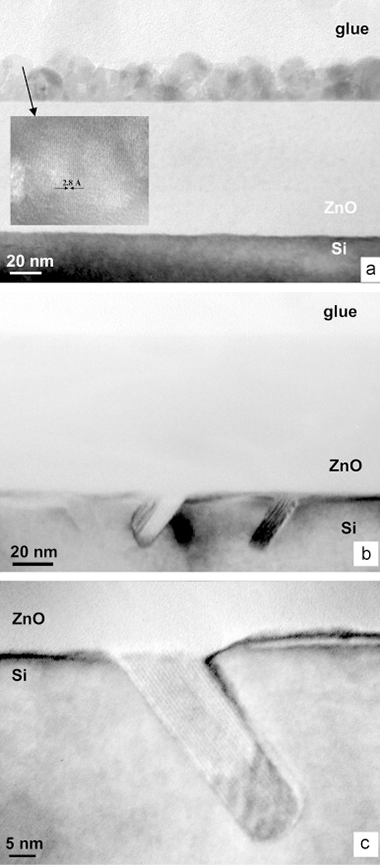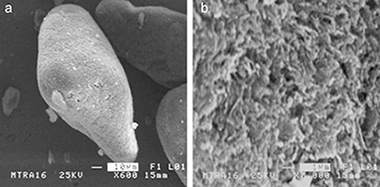Artículos SCI
2009
2009
Materiales Nanoestructurados y Microestructura
Chemical and electronic interface structure of spray pyrolysis deposited undoped and Al-doped ZnO thin films on a commercial Cz-Si solar cell substrate
Gabas, M; Barrett, NT; Ramos-Barrado, JR; Gota, S; Rojas, TC; Lopez-Escalante, MCSolar Energy Materials and Solar Cells, 93 (2009) 1356-1365
Show abstract ▽

We have studied differences in the interface between undoped and Al-doped ZnO thin films deposited on commercial Si solar cell substrates. The undoped ZnO film is significantly thicker than the Al-doped film for the same deposition time. An extended silicate-like interface is present in both samples. Transmission electron microscopy (TEM) and photoelectron spectroscopy (PES) probe the presence of a zinc silicate and several Si oxides in both cases. Although Al doping improves the conductivity of ZnO, we present evidence for Al segregation at the interface during deposition on the Si substrate and suggest the presence of considerable fixed charge near the oxidized Si interface layer. The induced distortion in the valence band, compared to that of undoped ZnO, could be responsible for considerable reduction in the solar cell performance.
Agosto, 2009 | DOI: 10.1016/j.solmat.2009.02.018
Nanotecnología en Superficies y Plasma
Identification of hydrogen and deuterium at the surface of water ice by reflection electron energy loss spectroscopy
Yubero, F; Tokesi, KApplied Physics Letters, 95 (2009) 084101
Show abstract ▽

A nondestructive method to distinguish between hydrogen (H) and deuterium (D) at surfaces by reflection electron energy loss spectroscopy is presented. It is based on the analysis of the energy distributions of electrons elastically backscattered from surfaces containing H or D. We consider standard and deuterated water ices as test surfaces. The recoil energy of the backscattered electrons depends on the atomic mass of the targets, and the contributions of H, D, and O to the measured spectra can be easily separated. The results of Monte Carlo simulations corroborate the experimental findings.
Agosto, 2009 | DOI: 10.1063/1.3202402
Reactividad de Sólidos
High surface area α-alumina preparation by using urban waste
Martin-Ruiz, MM; Perez-Maqueda, LA; Cordero, T; Balek, V; Subrt, J; Murafa, N; Pascual-Cosp, JCeramics International, 35 (2009) 2111-2117
Show abstract ▽

A new method for preparing high surface area α-alumina from urban waste is proposed. The method consists of the precipitation of a precursor that contains bohemite mixed with a linear polymer and subsequently the thermal decomposition of the precursor by heating in nitrogen and air to 1200 °C. The resulting α-alumina consists of nanocrystals of about 100 nm aggregated into larger particles with relatively high surface area (12 m2 g−1) and a significant macropore volume of 0.545 cm3 g. Methods of X-ray diffraction (XRD), scanning electron microscopy (SEM), high-resolution transmission electron microscopy (HRTEM) and selected area electron diffraction (SAED) were used to characterize microstructure of prepared materials. Results of differential thermal analysis, thermogravimetry and emanation thermal analysis characterized the thermal behaviour of α-alumina precursors.
Agosto, 2009 | DOI: 10.1016/j.ceramint.2008.11.011
Materiales Coloidales
Synthesis by pyrolysis of aerosols and ceramic application of Cr-doped CaYAlO4 red–orange pigments
Lyubenova, TS; Carda, JB; Ocana, MJournal of the European Ceramic Society, 29 (2009) 2193-2198
Show abstract ▽

The synthesis of red–orange Cr-doped YCaAlO4 pigments has been improved (softer thermal conditions and lower environmental impact) and optimised by using the pyrolysis of aerosols method. We also study the crystallochemical features of the Cr chromophore with special emphasis on its oxidation state which has not been yet clarified, finding that Cr(III) and Cr(IV) species are present in the octahedral and interstitial tetrahedral sites of the YCaAlO4 lattice, respectively. Finally, the applicability of this system as ceramic pigment was tested using conventional industrial glazes. A change from orange to pink shades was detected after glaze firing, which is mainly attributed to the Cr3+ to Cr4+ oxidation.
Agosto, 2009 | DOI: 10.1016/j.jeurceramsoc.2009.01.020
Química de Superficies y Catálisis
Aluminium anodisation for Au-CeO2/Al2O3-Al monoliths preparation
Sanz, O; Martinez, LM; Echave, FJ; Dominguez, MI; Centeno, MA; Odriozola, JA; Montes, MChemical Engineering Journal, 151 (2009) 324-332
Show abstract ▽

The anodisation of aluminium monoliths was performed in order to generate an alumina layer that ensures a good adherence of the catalysts. In this study, it is demonstrated that the morphology of the produced alumina layer depends on time, temperature, current density and concentration of the selected electrolyte. When anodisation process with the extreme conditions was applied (30 °C, 50 min, 2 A dm−2 and 2.6 M of sulphuric acid) a significant cracks were obtained and used to fix the subsequent catalytic coatings. The washcoating method was used to cover the monoliths with colloidal solutions of CeO2 and/or Au-CeO2 catalysts. The resulting monolithic catalysts were tested in the CO oxidation reaction being 1%Au-CeO2 containing system the most active. The structured catalyst prepared this way changed neither the textural nor the catalytic properties of the deposited catalytic powders.
Agosto, 2009 | DOI: 10.1016/j.cej.2009.03.062
- ‹ anterior
- 393 of 422
- siguiente ›














